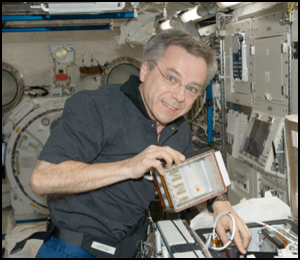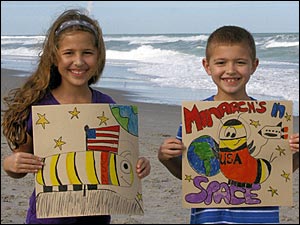
Welcome! On November 16, 2009 three monarch caterpillars from Monarch Watch lifted off with the space shuttle Atlantis (STS-129), destined for the International Space Station. Thousands of "Monarchs in Space" participants raised monarchs in the classroom or at home and watched as the monarchs on the ISS completed their development and emerged as adult butterflies - the first monarchs in space! The Limited Edition Monarchs in Space Poster is now available to commemorate this unique experience (and help support Monarch Watch): |
PROJECT LOG |
|
12 Mar 2010 Our three monarchs that spent most of their lives in space have made their way back to us, completing their 40.2 million mile journey! This amazing trip has been summarized in a recent blog post "Monarchs in Space: The Return" - check it out! 22 Feb 2010 9:01am UTC We have posted all of the Monarchs in Space Survey comments for your viewing pleasure - be sure to browse through them when you have a chance to see how participants responded to our Monarchs in Space project. Lots of great feedback! 22 Feb 2010 3:20am UTC The space shuttle touches down on runway 15 of the Shuttle Landing Facility at the Kennedy Space Center in Florida, completing its 5,750,000 mile flight (217 orbits of the Earth!) on its 13-day mission (MET 13:18:06:24). Welcome home Endeavour!
8 Feb 2010 9:01am UTC Endeavour, you are cleared for launch - good luck and godspeed! 7 Feb 2010 9:30am UTC Shuttle launch attempt scrubbed due to low cloud cover - we'll try again tomorrow! 1 Feb 2010 8:23pm UTC The results are in! 251 participants took the time to complete a short survey about this special project and we have posted a Monarchs in Space Survey Summary online for your viewing pleasure. As a part of the survey we also received lots of comments and we will be posting these soon. 13 Jan 2010 8:38pm UTC We are in the process of putting together a limited edition Monarchs in Space commemorative poster (available soon!) and we would love to include lots of participant photos! Please pick a few of your favorite photos that you took during this project and send them via email to us at space@monarchwatch.org by this Saturday, January 16th for consideration. We won't be able to use all submitted photos due to space limitations, but they will all be added to our online gallery. Please don't feel bad if your photo(s) don't make it to print In your email message, include your name as you would like it to appear in the photo credits as well as a brief caption for the photo(s). Captions will not be printed on the poster, but will be added to the online photo gallery available below. Do not resize the photos to make them smaller since we'll pretty much need the largest photos you can send to assure a quality print. Sending the original photos from your digital camera will be the best option. If you are scanning photos, please make sure they are at least 300 pixels per inch at the original print size. If you have already submitted photos, please submit your favorites again so that we know we have your permission to use them on the poster. 6 Jan 2010 9:13pm UTC Space shuttle Endeavour, atop its mobile launch platform, leaves the VAB and begins its 6 hour, 3.4 mile journey to Launch Pad 39A at the Kennedy Space Center in Florida. Endeavour is scheduled for a February 7th launch. STS-130's primary objective is to retrieve the monarch habitat from the ISS and return it to Earth. Oh, and the astronauts will be delivering a little hardware as well - the 15,500kg Tranquility node and 1,805 kg Cupola, two of the last main components to be added to the International Space Station. 31 Dec 2009 9:45pm UTC A preliminary "What Was Learned" text has been posted, summarizing our observations. Additional results will be posted online soon. 21 Dec 2009 8:30pm UTC Morse Elementary School took some great video of one of their "Monarchs in Space" monarchs emerging (and the kids' reaction) - it has been added to our Monarchs in Space Photo & Video Gallery so go check it out! 19 Dec 2009 11:55pm UTC New resource posted in the "Monarch Rearing Resources" section below: How to Maintain Adult Monarchs - a short guide to maintaing monarch butterflies at home or in the classroom 18 Dec 2009 9:26pm UTC We've created an online survey and sent a link to all Monarchs in Space participants via email. If you received a Monarchs in Space rearing kit from us but did not receive the message about the survey, please contact us at space@monarchwatch.org (please include your name and that of the person that ordered the kit) and we'll get back to you ASAP with details. Thank you in advance for providing valuable feedback and stay tuned to this site for a summary of the results! 11 Dec 2009 11:44pm UTC We expected the monarchs in space adult lifespan to be approximately one week, versus the typical 2-4 weeks in the spring and summer - and this is precisely what has been observed. The three monarchs successfully emerged as adult butterflies on December 3rd & 4th and as of today all have expired. Failure to find and/or use the nectar feeder is likely a major contributing factor, but is only speculation until we get a chance to review all of the video. Overall, the monarchs in space exceeded our expectations in regards to the challenges introduced by a microgravity environment. Well done! For those of you participating at home or in the classroom, your task now is to wrap up the experiments. If you were able to maintain your habitats at temperatures in the 70s, you should have adult monarchs butterflies by now. The caterpillar rearing chambers are too small for the adults and they should be moved to larger enclosures where they can easily feed themselves and even fly a bit. We will post additional instructions on how to care for the adult monarchs shortly. The newly emerged adults will not need to be fed the first day, but the next day they can be fed a sugar-water or honey-water solution. Mix 1 part sugar or honey with 9 parts water and pour into a shallow dish. A plastic pot scrubber, sponge, or cotton ball should be placed in the dish to aid in feeding. The food must be changed every day to prevent fermentation. As an alternative, you can use Gatorade or Juicy Juice. The feeding solution should be placed near the top of the cage and relatively close (within 10-20 inches) to the light source. Like most insects, monarchs will fly toward lighted windows or artificial lights.
If you hurry, you can be the first to post a question in response to his welcome video "Ask Astronaut Jeff Williams". (Image:NASA) 9 Dec 2009 10:28pm UTC New video posted: International Space Station Mission 22 Commander Jeff Williams congratulates scientists on the occasion of the first monarch butterfly emerging from its chrysalis. "Beautiful...it's always good to see a little bit of Earth up here." Thanks Commander! 6 Dec 2009 2:40am UTC Check out the video of Monarch #2 expanding his wings - more photos of the flight and ground monarchs added too! Monarchs in Space Photo & Video Gallery 4 Dec 2009 10:50pm UTC Emergence of ISS Monarch #2 caught on video! Clip now available in our Monarchs in Space Photo & Video Gallery. Wow! 4 Dec 2009 6:30pm UTC The final ISS monarch has emerged - we were a bit concerned about this one and it appears that although it was able to emerge from the pupal case, it was not able to pump its wings up as the other two monarchs did. We'll have more to say about this soon! 4 Dec 2009 2:44am UTC Ah-ha! We now know exactly how the final monarch pupa became a "floater" thanks to the newest video posted in our Monarchs in Space Photo & Video Gallery. Watch the female monarch go for a little joyride...
3 Dec 2009 10:14pm UTC In sync with the monarchs on the ISS, their Earthbound counterparts emerged today as well - a male and a female. Each chamber now has one pupa left to emerge, probably sometime tomorrow. 3 Dec 2009 8:06pm UTC Monarch butterfly #2 has emerged - it's a boy! Check out some photos via our Monarchs in Space Photo & Video Gallery. The third pupa is approximately 14- 18 hours behind the first two and therefore will probably not emerge until tomorrow. We should watch it carefully though as the day progresses - it could still emerge later.
3 Dec 2009 7:13pm UTC One of the monarchs on the International Space Station is emerging right now - the downlink has been temporarily severed but NASA is recording the video to capture the event and we will post photos and video as soon as possible. How exciting! 3 Dec 2009 5:29pm UTC At least two chrysalids are definitely going to emerge today...won't be long now! 2 Dec 2009 11:47pm UTC The chrysalids are definitely beginning to change color so we should have at least one monarch (perhaps all three monarchs) emerge tomorrow! Check out the latest photos via our Monarchs in Space Photo & Video Gallery. 1 Dec 2009 5:04pm UTC We expect the monarchs to eclose (emerge) on Thursday - we will have a better idea when we see the last images from today. Getting out of the pupal case is the next challenge and then the butterflies have to be able to cling to the surface and expand their wings. This will be a real challenge since two of the monarchs are not attached to a surface as they would be on earth. One is a floater and another stuck on the plexiglass on its back. It will be amazing if these two emerge normally and even more amazing if wing expansion is normal. Stay tuned!
24 Nov 2009 11:41pm UTC Three for three - the last monarch caterpillar on the International Space Station has just pupated. We hope to have some video of this online soon. Stay tuned! In the meantime, check out the latest photos via our Monarchs in Space Photo & Video Gallery. 24 Nov 2009 8:50pm UTC Monarch #2 has pupated as well. It was not able to embed the cremaster into the silk pad though and is free floating at the moment. It appears, however, that is was able to pull itself together and assume the typical shape of the pupa. This is going to be interesting to watch. Check out the latest photos via our Monarchs in Space Photo & Video Gallery. 24 Nov 2009 7:50pm UTC Houston, we have pupation! One of the three monarch caterpillars on the ISS has successfully pupated to form the chrysalis. The other two should follow soon. The "astropillars" are not hanging in the typical "J" formation, they are more curled up like a "C" instead. Two of the Earth-based caterpillars have assumed the J position and should pupate soon. Check out the latest photos via our Monarchs in Space Photo & Video Gallery. 24 Nov 2009 6:12pm UTC The hatches between Space Shuttle Atlantis and the International Space Station closed. 24 Nov 2009 9:45am UTC Latest photos posted! Looks like all three ISS monarch are off the diet and at least one is beginning to lay down a silk mat in preparation of pupation. View all in the Monarchs in Space Photo & Video Gallery. 23 Nov 2009 9:52pm UTC Latest photos and videos posted! Looks like we may have at leat one ISS monarch beginning to wander a bit in search of a good place to pupate. View all in the Monarchs in Space Photo & Video Gallery. 23 Nov 2009 5:41pm UTC The monarch caterpillars on the ISS are currently passing over the monarch overwintering areas in Mexico. The overwintering monarch butterflies on Earth are at an altitude of approximately 10,000 feet and have travelled at most about 2,500 miles (in up to 10 weeks) at a rate of 12 mph or so. In contrast, our "astropillars" are at an altitude of approximately 1,100,000 feet and have traveled a bit more than 3,000,000 miles (in just under 1 week) at an average rate of over 17,000 mph. Wow! 23 Nov 2009 5:15pm UTC Pinkish frass observed in the foreground the latest ISS caterpillar images - this indicates that larvae are beginning to evacuate their guts prior to spinning the bed of silk for pupation. As the caterpillar empties its gut, the frass goes from normal to pink to reddish. This color comes from the nitrogenous wastes and acids (some uric acid) extracted from the hemolymphby the Malpighian tubules and deposited in the hindgut. 23 Nov 2009 4:44am UTC Additional photos of the ISS monarchs and the ground control group posted. View all in the Monarchs in Space Photo Gallery. 22 Nov 2009 5:15pm UTC Additional photos of the ISS monarchs and the ground control group posted. View all in the Monarchs in Space Photo Gallery. More photos from the Kennedy Space Center are also online. 21 Nov 2009 Additional photos of the ISS monarchs and the ground control group posted. View all in the Monarchs in Space Photo Gallery. 20 Nov 2009 Additional photos of the ISS monarchs and the ground control group posted. View all in the Monarchs in Space Photo Gallery. 19 Nov 2009 5:47pm UTC The monarchs on the ISS are molting (or preparing to molt) to the 5th and final caterpillar instar. Caterpillars at home or in the classroom shouldn't be too far behind - check out "Molting from Fourth to Fifth Instar" for a description and explanation of what will be happening. 19 Nov 2009 5:02pm UTC First video of the monarch caterpillars on the ISS - as the photos indicate, all are feeding and doing well! Videos will be available throughout this project via the "Photo & Video Gallery" link below. 18 Nov 2009 11:18pm UTC First photos of the monarch caterpillars on the ISS - all are feeding and doing well! Photos will be available throughout this project via the "Photo & Video Gallery" link below.
18 Nov 2009 3:51pm UTC Atlantis successfully docks with the ISS, 220 miles above Australia and Tasmania. 16 Nov 2009 7:28pm UTC Flawless Launch! Atlantis lifts off with monarch caterpillars and Mission STS-129 to the International Space Station (ISS) begins. The monarchs in their chamber account for about 0.00004% of the 4.5 million pounds of hardware and humans headed for the ISS. 15 Nov 2009 5:21pm UTC Payload transport truck leaves for Launch Pad 39A; monarchs loaded onto Atlantis. 15 Nov 2009 4:35pm UTC Monarch caterpillars transported to the Space Life Sciences Lab (SLSL) and loaded into locker MA16D destined for Atlantis' mid deck. 15 Nov 2009 2:50pm UTC Monarch caterpillars in their habitat passed off to NASA. 15 Nov 2009 10:00am UTC Assembly of monarch chambers and installation of monarch caterpillars begins. Location: Space Station Processing Facility (SSPF) at the Kennedy Space Center in Florida. 11-13 Nov 2009 Special monarch rearing kits sent to more than 400 schools and many homes for participation in the Monarchs in Space Project. |
PROJECT PHOTOS & VIDEO |
Here you will be able to see photos and video downloaded from the International Space Station as well as those submitted by participants. If you would like to submit photos of your project, please send them to us via email at and we will post them as soon as possible. If you would like to share video please upload to YouTube and then send us the link via email at space@monarchwatch.org.
|
MONARCHS IN SPACE PARTICIPANT WEBSITES |
Have you created your own website to document your Monarchs in Space project? If so, please send us the link via email at space@monarchwatch.org and we will add it here to share with the world!
|
COMMENTS FROM PARTICIPANTS |
The feedback we have received regarding our Monarchs in Space program has been overwhelmingly positive. All comments are welcome - please send them to us via email at space@monarchwatch.org. To make things easy on our webmaster (ok, yeah, that's me) please use "MIS Comments" as the subject of the email message. Thanks! ~Jim Featured comment:
|
MEDIA COVERAGE |
Listed here is coverage that we know about (many contain photos and or video) - if you come across other mentions this program please let us know via our Monarchs in Space Forum or email! The Gold County Times: Plymouth Elementary School Gardens #16; Monarchs in Space The Journal Gazette: Class compares notes with NASA Space.com: First Monarch Butterflies in Space Take Flight Space Fellowship: Science and Solar Array Troubleshooting for Station Crew MSNBC: First Monarch butterflies in space take flight Lawrence Journal-World: Fascinating Sight The Huffington Post: Butterflies In Space Station Fox 4 Kansas City (video): Kids Captivated by Butterflies in Space The Journal-Times: Bull Fine Arts Elementary School fourth-grade students participating in Monarchs in Space Program News Democrat Georgetown, OH: GHS joins NASA program Toledo Blade: Butterflies' survival has Toledo area youths fascinated Fox40 WICZ: Students' Butterflies in Space Lawrence Journal-World: KU monarch butterfly emerges in space Space Fellowship: Expedition 22 Crew Busy with Science, Maintenance and Buterflies The News-Gazette Urbana, IL: Leal kids comparing their caterpillars to those in space Texarkana Gazette: Butterfly experiment going well at Kilpatrick Williamsport Sun-Gazette: West Branch students compare data with Atlantis crew The Times: Galesburg caterpillars have siblings in space WCPO Georgetown, OH: Local Students jon NASA Program Experiment WCPO Georgetown, OH (video): Local Students jon NASA Program Experiment Times Union Bethleham, NY: Preschool studies butterflies for NASA Galesburg, IL: 2 Knox County classrooms participate in NASA experiment Daily Kos: Monarch to Launch into Space KWQC Davenport, IA: Galesburg Students Participate In Space Experiment WAND TV, Urbana, IL (video): Area students use shuttle launch to learn about caterpillars Illinois Homepage, Urbana, IL (video): Leal Science Project WBNG Binghamton, NY: Vestal students work with NASA KU News Release: KU monarch caterpillars to voyage on space shuttle to International Space Station Lawrence Journal World: KU to launch Monarch butterflies into space KCTV Kansas City: KU Professor To Send Monarchs Into Space LJ World Blog: What would a Monarch Butterfly look like floating in outer space? The Wichita Eagle: KU monarchs to take part in gravity study in space EurekAlert! Science for Kids: University of Kansas helps monarch butterflies head into space Kansas City InfoZine: KU Monarch Caterpillars to Voyage on Space Shuttle to International Space Station The Register: Butterflies In Spaaaace! Royal Institute of Navigation: Monarch butterflies in space |
MONARCH REARING RESOURCES |
|
How to Maintain Adult Monarchs - a short guide to maintaing monarch butterflies at home or in the classroom Monarch Butterfly Protocol (15K PDF, 1 page) - Timeline and protocol for monarch butterflies headed for the ISS. For those of you raising monarchs: The protocol for the shuttle (above) calls for the introduction of early 4th instar larvae into the capsule at 10AM EST Sunday the 15th of November. If you can't load the larvae into your habitat at this time, introduce the larvae, perhaps during a class period, at 10AM EST on Monday the 16th. Monarchs in Space Guide (100K PDF, 11 pages) - A companion guide containing background info and discussion of the challenges monarch will face in space as they pertain to their natural development. Monarchs in Space Glossary - a list of some terms used in the materials for this project...and their definitions of course! Creating a Monarchs in Space Rearing Chamber - a simple photo guide to creating your own rearing chamber Monarchs in Space Plan A (1.9MB PDF, 3 pages) - Steps to prepare the Monarch Butterfly habitat from BioServe Monarchs in Space Plan B - description and setup guide General Tips for Experiment (16K PDF, 1 page) - Lighting, temperature, humidity, etc. Frequently Asked Questions - answers to some of the questions we've received since we announced this program. Butterflies in Space Teacher's Guide (4.7MB PDF, 29 pages) - this guide is geared toward a Painted Lady butterfly project but it also contains lots of useful general information as well.
|
LINKS TO OTHER RESOURCES |
Monarchs in Space Online Forum - ask questions and share your thoughts with other participants Latest Space Shuttle News - up to date information, direct from NASA ISS Tracker - free tool for educational purposes; real-time status information. Human Space Flight (HSF) - Orbital Tracking - track the Space Shuttle and International Space Station NASA Spacecraft Sighting Opportunities - find out when spacecraft will fly over your city! |
BACKGROUND |
The next Space Shuttle launch is scheduled for November 16th (Mission STS-129). Atlantis will carry three 4th instar monarch caterpillars supplied by Monarch Watch to the International Space Station (ISS) in a small rearing chamber. This chamber will be placed in an incubator onboard the ISS where the developing monarchs will be monitored. Still and video cameras will continually capture images, which will be made available online. We have prepared a text that outlines normal development of monarchs from the 4th instar until emergence as adults (see "Monarchs in Space Guide" below). This detailed text is written for adults and contains an extensive glossary. It is intended to provide the information teachers need to answer student questions and as a guide to the five major challenges monarchs face in the nearly weightless environment of the International Space Station. Participation More than 400 classrooms (and many homeschoolers and individuals) in the U.S. east of the Continental Divide have received a monarch caterpillar kit from Monarch Watch so they can raise monarchs here on Earth follow the shuttle mission to the space station and the development of the monarchs in space for at least two weeks. PLAN A: The first 20 classrooms that responded will take part in Plan A, the original experiment as it was designed. A rearing chamber will be provided by BioServe Space Technologies to house the monarch caterpillars received from Monarch Watch. PLAN B: Monarch Watch will send a special monarch caterpillar kit containing six 3rd instar caterpillars and artificial diet to participants. We will also provide instructions for creating a simple rearing chamber that will approximate the conditions of the chamber that will be transported to the ISS - microgravity not included. |
DONATE NOW! (pretty please) |
|
Monarch Watch is a non-profit program based at the University of Kansas and we need your financial help to allow us to continue to offer educational, conservation, and research programs. If you enjoy and/or appreciate all that Monarch Watch offers throughout the year, please consider making a donation today - it's quick, easy, secure, and fully tax-deductible. You can even set up a recurring gift (monthly or annually) if you'd like. We rely on contributions from Monarch Watchers just like you to keep the program going - thank you for your continued support! If you would rather mail in a donation or have questions, please visit Giving in Support of Monarch Watch. |

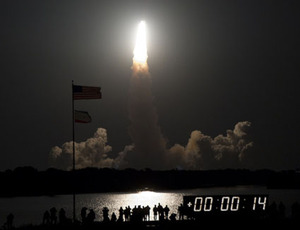 8 Feb 2010 9:14am UTC Six million four hundred twenty-five thousand pounds of thrust provided by the solid rocket boosters and main engines lifts Endeavour off the Earth in a brilliant nighttime launch from Pad 39A at the Kennedy Space Center in Florida.
8 Feb 2010 9:14am UTC Six million four hundred twenty-five thousand pounds of thrust provided by the solid rocket boosters and main engines lifts Endeavour off the Earth in a brilliant nighttime launch from Pad 39A at the Kennedy Space Center in Florida. 10 Dec 2009 3:35pm UTC Astronaut Jeff Williams, aboard the International Space Station 220 miles above Earth, is taking your questions. Post a video response with your question about his experience with his monarch "roommates" (or anything else) - Williams' schedule will not allow him to answer many questions, but he will attempt to answer a few each week. If you have access to YouTube you can
10 Dec 2009 3:35pm UTC Astronaut Jeff Williams, aboard the International Space Station 220 miles above Earth, is taking your questions. Post a video response with your question about his experience with his monarch "roommates" (or anything else) - Williams' schedule will not allow him to answer many questions, but he will attempt to answer a few each week. If you have access to YouTube you can 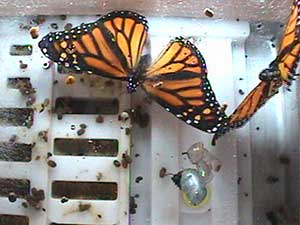 4 Dec 2009 2:44am UTC Oops! It seems that the last monarch pupa aboard the ISS has been dislodged from the side wall by the movement of the two adult butterflies. This will certainly add a bit of drama to its emergence later today ;-)
4 Dec 2009 2:44am UTC Oops! It seems that the last monarch pupa aboard the ISS has been dislodged from the side wall by the movement of the two adult butterflies. This will certainly add a bit of drama to its emergence later today ;-)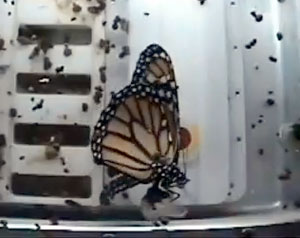 3 Dec 2009 8:00pm UTC It's a girl! A short video has been posted in our
3 Dec 2009 8:00pm UTC It's a girl! A short video has been posted in our 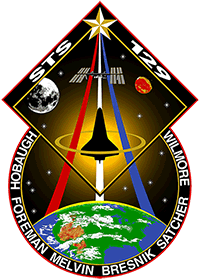 27 Nov 2009 2:45pm UTC Atlantis safely touches down on runway 33 at the Kennedy Space Center - a picture perfect ending to STS-129, its 4,490,138-mile mission to the International Space Station. Welcome home Atlantis!
27 Nov 2009 2:45pm UTC Atlantis safely touches down on runway 33 at the Kennedy Space Center - a picture perfect ending to STS-129, its 4,490,138-mile mission to the International Space Station. Welcome home Atlantis!